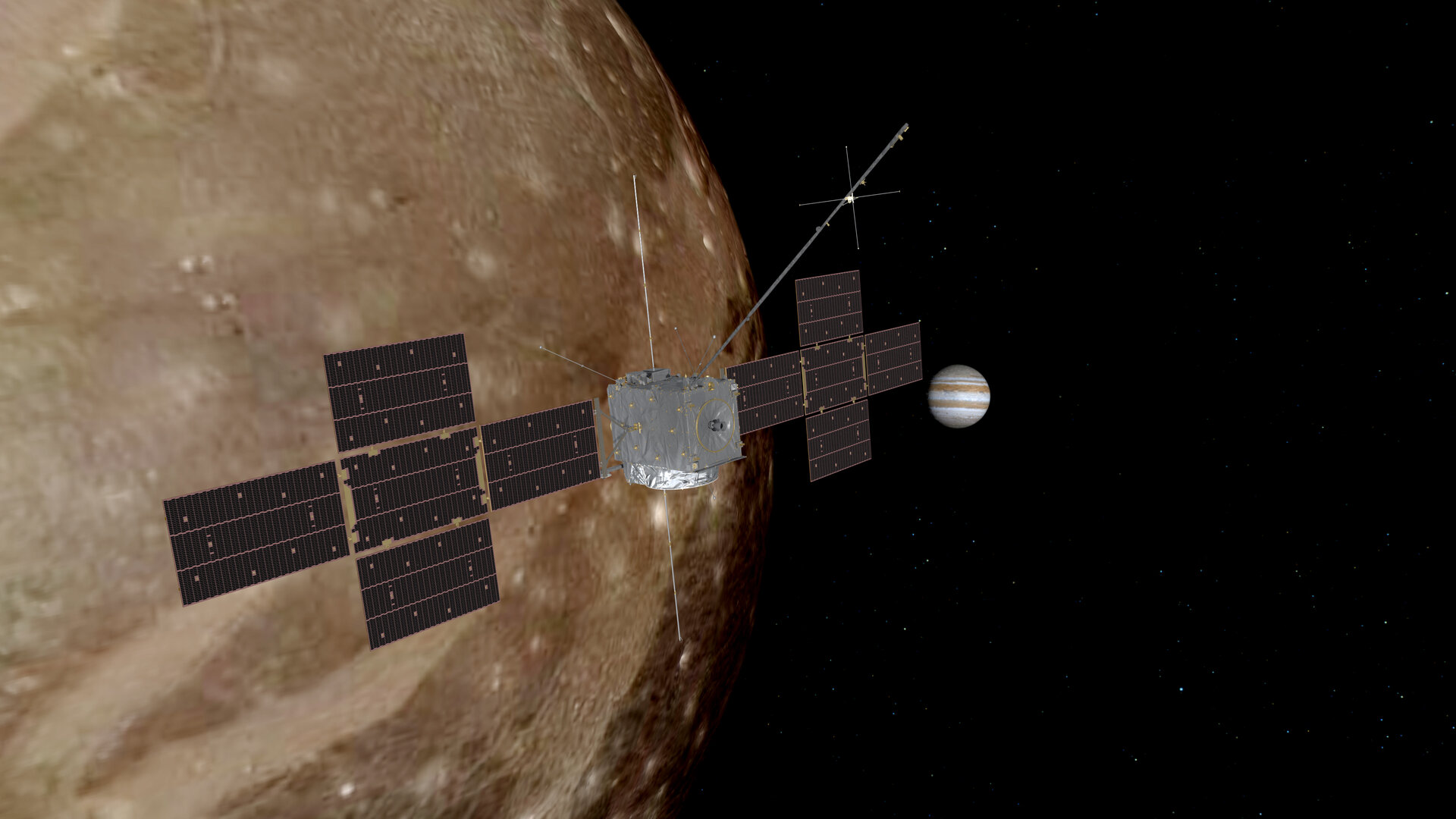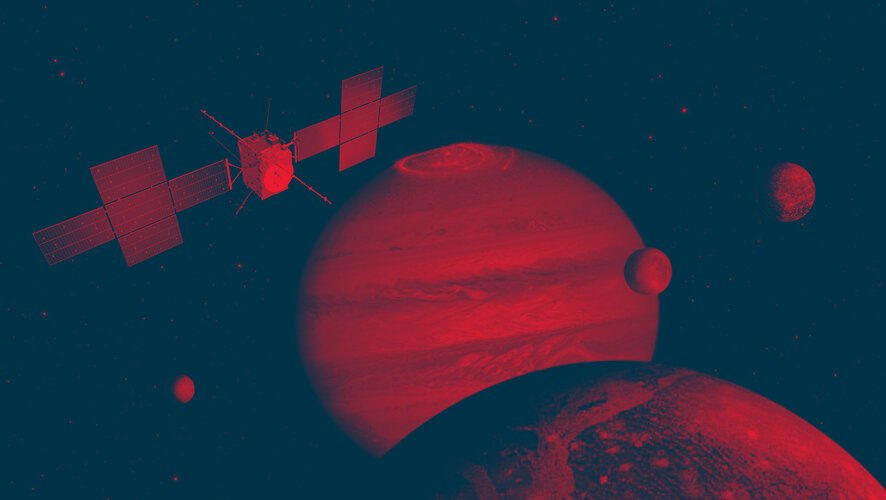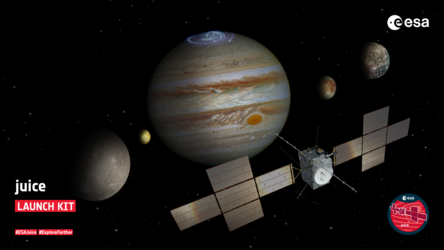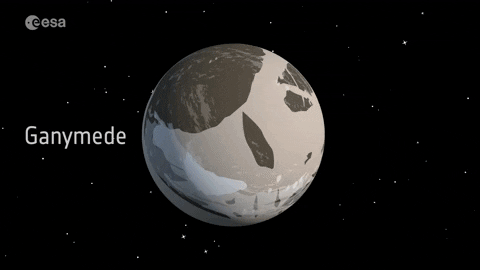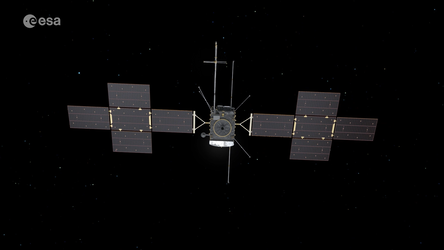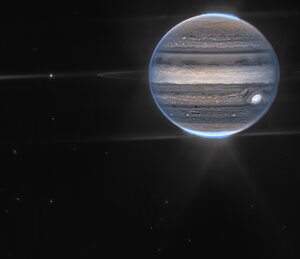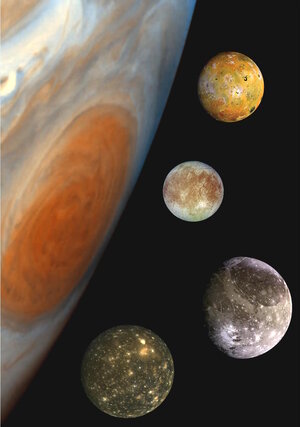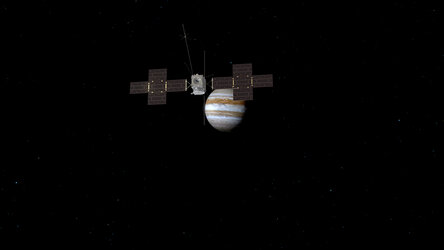Spotlight on Ganymede, Juice’s primary target
A key focus of ESA’s Jupiter Icy Moons Explorer (Juice) will be Ganymede: Jupiter’s largest moon, and an ideal natural laboratory for studying the icy worlds of the Solar System.
Why focus on Ganymede?
There are a handful of key reasons Juice will home in on Ganymede.
Firstly, Ganymede is thought to have a salty ocean beneath its icy shell. This ocean may be large enough to wrap around the entire planet, although we’re unsure of what it’s like. What is it composed of, and how deep is it? One of Juice’s key goals at Ganymede is to explore this body of water, while also comparing it to Jupiter’s other ocean-bearing moons to get a clearer picture of these worlds as potential habitats for life.
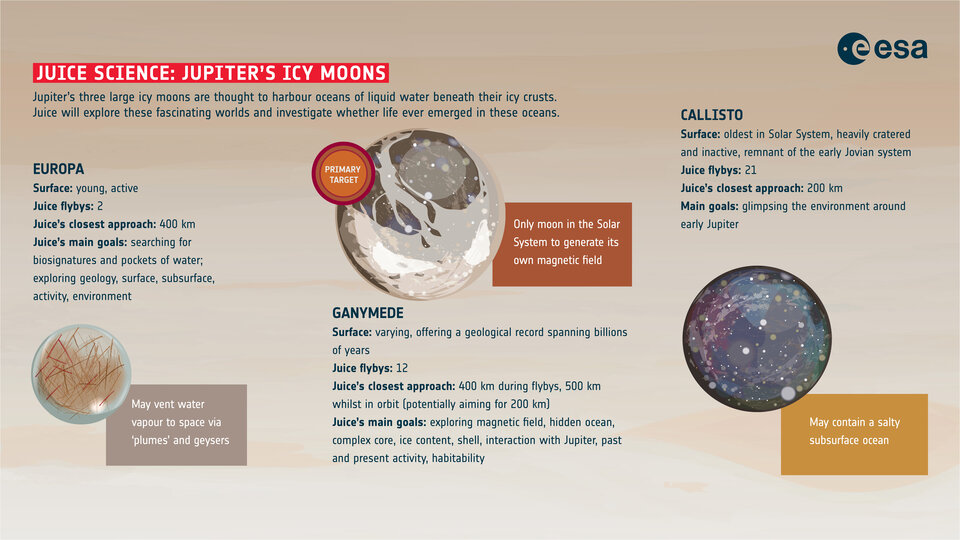
Ganymede also displays complex interactions with the space environment around Jupiter, one of the most intense and dynamic regions in the Solar System. It is also the only moon – and one of only three solid bodies – in the Solar System to generate its own intrinsic magnetic field. How does it do this? What drives and maintains Ganymede’s internal dynamo, and why don’t we see one on other moons?
Ganymede’s magnetic field forms a little magnetic bubble (a magnetosphere) that exists within the larger magnetosphere of Jupiter itself; this bubble constantly interacts with the electromagnetic fields and hot, ionised matter (plasma) flooding the region, and produces strong auroras. Juice will measure the magnetic and electric fields, energetic particles, atoms and molecules, and processes seen around Ganymede, and unpick how these interact with Jupiter’s environment, radiation belts and other moons. This is essential if we’re to understand how satellites form, evolve and exist not only in the Jupiter system, but in gas giant systems elsewhere in the cosmos.
Last but not least, Ganymede holds a unique position in the Jupiter system in terms of its geology and evolution, providing a window into the history of the system over several billions of years.

The moon’s complex surface is very varied in age and offers both the old, pockmarked terrain seen on Callisto and the lighter, smoother resurfacing seen on Europa. By studying Ganymede’s surface features, scientists can therefore gain insight into how impacts from space and geological processes such as tectonics have shaped Jupiter’s moons over time. This includes mapping Ganymede’s surface composition – especially in regions where there may be traces of past processes such as space weathering, cryovolcanism and tectonics – and determining the physical properties of the moon’s ice shell, which is thought to be up to 130 km thick.
How will Juice do this?
Juice is a unique mission. It will be the first spacecraft to orbit a moon other than our own, and also the first to change orbit from another planet to one of its moons (Jupiter to Ganymede). It will first orbit Jupiter, performing numerous flybys of the planet’s moons – including 12 of Ganymede – as it loops around the gas giant. Juice will then hop across to Ganymede and begin its in-depth study of the moon. (More on Juice’s journey to Jupiter.)
Juice will measure how Ganymede rotates, its gravity and geophysics, its shape and interior structure, its magnetic field and atmosphere, its composition and mineralogy, its icy crust and surface features, its emissions to space and interactions with its surroundings, and, crucially, its subsurface ocean. It will complete a ‘tomography’ of Ganymede for the first time, observing it from multiple perspectives to reconstruct a view of its interior, and assess the moon’s biosignatures (elements thought to be biologically essential, although not sufficient, for life: examples include carbon, oxygen, magnesium, iron and liquid water).
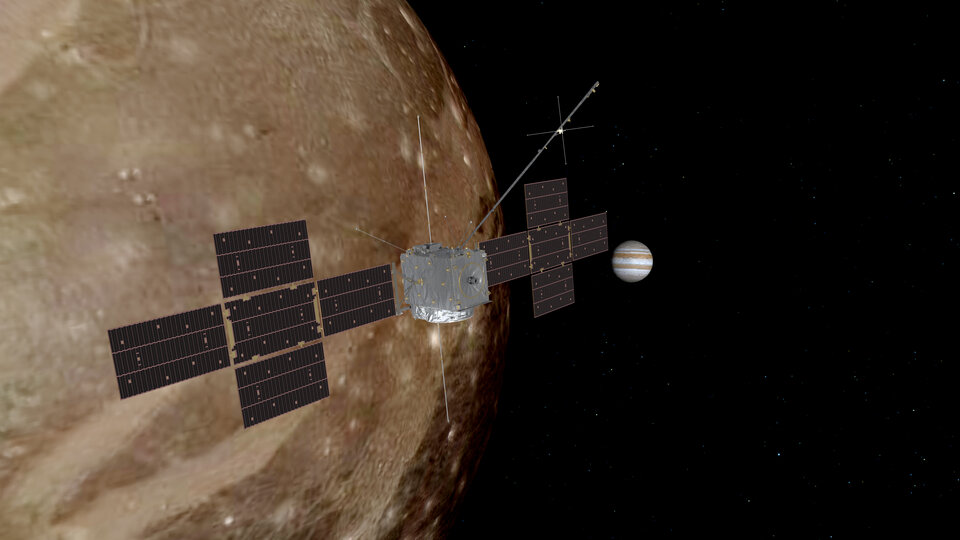
The spacecraft will probe each of Ganymede’s layers individually: its core (thought to be liquid and iron-rich), mantle (rocky and icy), salty ocean, ice shell, magnetosphere and tenuous atmosphere (including the outermost layer – the exosphere). To do this, the spacecraft is equipped with 10 state-of-the-art scientific instruments, as well as one experiment (PRIDE) and one radiation monitor (RADEM). This payload will tackle the mission's science goals by acquiring remote sensing (from a distance), in situ (‘on-site’) and geophysical observations.
Below are some of the objectives of Juice pertaining to Ganymede, with the associated instrument(s) indicated in parentheses.
Juice will…
- Measure the components of Ganymede's magnetic field (J-MAG)
- Observe the energetic particles found there, and reveal how they interact with both Jupiter's magnetosphere and Ganymede’s surface (RPWI, PEP, RADEM)
- Explore Ganymede’s auroras (combination of remote sensing – UVS, MAJIS and JANUS – and in situ instruments)
- Measure the density and chemical composition of Ganymede’s tenuous atmosphere and ionosphere (PEP, 3GM, PRIDE, RIME, and all remote sensing instruments)
- Characterise the composition and physical properties of Ganymede's surface (MAJIS, UVS, SWI, and 3GM in bi-static radar mode), including mapping its full surface at a resolution of 100 to 400 m per pixel and studying the moon's geology (JANUS)
- Map regions of interest at high spectral and spatial resolution (remote sensing instruments, radar and GALA), also measuring the topography and roughness of surface regions (GALA)
- Acquire the first ever direct subsurface measurements of Ganymede with its ice-penetrating radar (RIME)
- Characterise the subsurface ocean by measuring surface tides (GALA), Ganymede’s gravity field (3GM), and the moon’s magnetic induction (J-MAG). Passive radar measurements with RIME and RPWI are also envisaged.
- Study the interior structure of Ganymede by measuring its gravity field and rotation (3GM, GALA, JANUS)
- Pinpoint the moon's precise position in the Jupiter system (3GM, PRIDE, JANUS).
Overall, Juice will paint a new, and complete, picture of Ganymede and its place in the Jupiter system.


